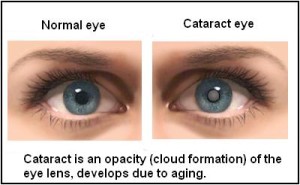What is a cataract?
If you make the analogy of the eye being like a camera, the eye also has a lens in it, just like a camera. A cataract is a clouding of the lens of the eye when it is normally clear. Depending on the size and location, it can interfere with normal vision. Cataracts can develop in both eyes, and one can be worse than the other.
Who gets cataracts?
Most cataracts develop in patients over 55, but they can occur occasionally in infants, young children, or people who have a blunt eye injury.
What causes cataracts?
Clouding of the lens of the eye occurs due to changes in the proteins of the lens fiber. Most cataracts are due to age related changes, however diabetes, certain medications, ultraviolet (UV) light, smoking, nutritional deficiency and injury to the eye, can promote the formation of cataracts.
How can you slow the progression of cataract formation?
Wearing UV-blocking lenses and reducing exposure to sunlight, decreasing or discontinuing smoking, increasing the intake of antioxidants and maintaining tight control of a diabetic’s blood sugar.
What are the symptoms and signs of cataracts?
Cataracts generally form slowly. But one may notice a sensitivity to glare from lights, (especially when driving at night), blurred vision, reduced intensity of colors, double vision and/or changes in an eyeglass prescription. Some of these changes can be very gradual, however, as the cataract worsens, the patient can become more symptomatic.
How are cataracts diagnosed?
With comprehensive dilated eye examination the lens of the eye can be viewed more extensively.
There are three different types of cataracts:
Nuclear: The most common type of age related cataract characterized by a gradual progression. This cataract is a clouding of the central part of the lens. As this type of cataract progresses, it changes the eye’s ability to focus and can change an eyeglass prescription. A patient may find their reading vision to be improved temporarily, but it is not permanent.
Cortical Spoking: A clouding of the circumference of the lens like spokes in a bicycle wheel. Patients with diabetes are at risk for developing these cataracts. These spokes can cause the light to scatter and can create problems with glare and contrast, as well as blurred vision.
Posterior Subcapsular: This type of cataract has the form of a small opacity in the posterior or back surface of the lens. These cataracts can interfere with reading and can a “halo and glare effect” around lights. People who use steroids for a long period of time (ex: by pill form, eye drop or nasal spray) or in an eye condition called retinitis pigmentosa, a person can develop this type of cataract. This type of cataract develops quickly and symptoms can become noticeable within months.
How are cataracts treated?
The treatment is based on the level of visual impairment for the patient and how much it affects the patient’s daily functioning. Surgically, the cataract (lens) is removed from the eye and an implant with the patient’s eye prescription is inserted in it’s place. There are many implants now available. There are implants that can correct astigmatism and also bifocal implants. These different types of implants should be discussed with the surgeon at your cataract evaluation to determine what is the best option for you. Some surgeons are performing cataract surgery via laser. The laser performs a precise incision and can break up the cataract using the laser’s impulses.
OUR LOCATIONS:
78 Salem Avenue
Carbondale, PA 18407
PHONE: (570) 282-2000 • FAX: (570) 483-8210
4 Meadow Avenue
Scranton, PA 18505-2337
PHONE: (570) 504-1530 • FAX: (570) 504-1533
216 Nazareth Pike
Bethlehem, PA 18020
PHONE: (610) 813-0342 • FAX: (610) 813-0628


Comments are closed